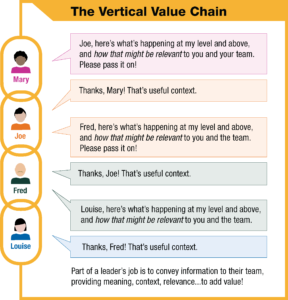For a pdf of this article, click here
Senior leaders often need to communicate messages to all employees. However, not all messages get through. This article describes how to fix that.
Here’s a quick video introduction
by Wendi and Bill.
5-minute read
The Frozen Middle is how executives often describe mid-level leaders who shrug off senior-level direction. Even for something as simple and vital as conveying messages to the rest of the workforce, those mid-level folks sometimes appear to think “Insulate” rather than “Communicate.”
But let’s not blame those leaders. They’re just responding to their own priorities, which include what and how they want to communicate. Fortunately, there are tactics that senior-level bosses can use to fix the problem. To understand them, it helps to first understand the Vertical Value Chain.
The Vertical Value Chain
In a well-running organization, every layer adds value. That includes anything that flows from one layer to another. In our leadership classes, we call this idea the Vertical Value Chain.
For example, right now a client of ours is cascading a strategic plan down their organization—with leaders at all levels adding value.
Here’s how: The senior leader crafted the organizational strategy with input from leaders at the next layer down. Those leaders, with input from their own direct reports, refined the strategy further into key strategic initiatives and milestones. Then, with input from their own direct reports, the last layer of leadership fleshed out milestones into specific achievements, actions, and time frames. Those will be assigned to named individuals.
Problems Communicating Down the Value Chain
So what’s the problem when communication doesn’t flow down effectively?
First—and most obviously—a mid-level leader may simply fail to relay information down the chain of command. Say a director attends an EVP’s meeting. Important stuff gets announced, discussed, or decided. And then the director goes back to their subordinates…and doesn’t mention any of it. Relaying such organization-wide information may simply not cross their minds, or it may get pushed aside by more pressing matters.
The second mistake is subtler: non-translation. Every layer of an organization needs to receive information in a way that’s meaningful and relevant to them. A typical example of non-translation: Employing a slide deck, a CEO presents an important new initiative to their EVPs, intending that the information be shared down the line. But the EVPs share only the slide deck with their subordinates, with no further explanation or tie-in to the work done at each level.
This sleight-of-hand gives the pleasant appearance of communication, but without the bother of actually doing it. “Information” isn’t informative until it’s put into meaningful context for each audience.
The Solution: Back to Basics
Given these two issues, there are a couple of basic skills senior leaders need to use that will ensure that information effectively flows down the Vertical Value Chain:
Expect communication: When we say “expect,” we mean spell out to direct reports their accountability for down-the-line communication. Have a deliberate conversation about this expectation; don’t just mention it in passing. Explicitly convey, for example, that relaying information down the organization is essential to the job of every leader at every level. That includes putting information into recipients’ frame of reference, so they understand and care about the message. It also means helping people connect their own work to the bigger picture and higher purpose of the organization, as we’ve written about for senior military leaders here.
Inspect communication: In this case, “inspect” means touching base with the supposed recipients of a down-the-line communication. For example, in a brief hallway exchange an executive might ask someone two or three levels below, “What do you think about that new personnel policy we announced last week?” If the exec gets a lousy answer—“Huh? What personnel policy?”—then it’s good to cast a wider net by asking a few more people the same question. If the executive keeps hearing lousy answers, then it’s time for a conversation with the person who was supposed to have relayed the message. (On the other hand, if the mid-level manager is communicating well, then a kind word about that would be in order.)
Bring Mid-Levels into the Huddle
Some messages need to come directly from the top brass. That includes company relocation, acquisition, divestiture, downsizing, restructuring, and so on. Big stuff. Communication vehicles might include an all-hands Zoom meeting, a video-based announcement, or an email.
But are we now cutting out those mid-level leaders? Remember, you need them to help ensure that your message is heard, understood, and maybe even embraced. What you don’t want are conversations down the ranks like this:
“Hey, boss, what’s the story on that thing the CEO announced today?”
“I dunno. I know as much as you do.”
What’s the fix? Involve the mid-levels in the communication before everybody else receives it.
For example, hold your Zoom session with them first to make sure they understand the pending announcement and can explain it themselves. Give them more information than you’ll give the whole crowd, and more time to think about it, so they can answer questions and look smart.
Or, if it’s an email you’re about to send to everyone, try this tactic, recently recommended by one of our clients: First send an email to the mid-levels saying, “Here’s what I’m planning to write to the whole organization. What do you think about my message, and what do you think about how I’m saying it?”
Will rumors leak out if the mid-levels are involved? Sure. But it’s worth drawing them into the effort and creating informed allies.
To our knowledge, this whole two-step approach was first researched by anthropologists trying to help nongovernmental organizations promote the use of condoms in African villages. The NGOs had been speaking directly to the villagers, and it wasn’t working. But when they first approached the traditional healer in each village and apprised them of the intent and message, it made a world of difference. Never end-run the local authorities!
In Summary
For senior leaders to communicate to their entire organizations, every link in their Vertical Value Chain must be strong. Each layer must add value, not just relaying the information, but also making it clear and relevant to employees.
This means senior leaders must spell out to direct reports their expectations that they communicate executive messages faithfully and in a way that adds useful context. It also means senior leaders must adopt the habit of confirming that important information has been relayed, by occasionally checking in with employees a few layers down.
Big announcements affecting the entire organization should come directly from senior leadership. However, mid-level leaders need to be clued in before the rest of the organization. That way, those leaders will be more inclined to support the message and will be able to explain or elaborate on it.
Communication is a vital task for any organization—but it is a task, and it can be delegated using time-tested leadership principles. Just one “frozen” manager in the chain of command can break the chain of communication, leaving everyone below them in the dark. Instead, work to develop an intellectual bucket brigade, where all brains are required, and all layers add value.


Mat Winter
Another relevant, useful and effective thought piece to remind “leaders” of their communication responsibilities……knowing that everyone in the company/organization is a “leader!” Well written and thank you for sharing!
bcasey
That’s a pretty darn good distillation, Mat! Thanks!
Lisa Wrolstad
Always love your quick reads that leave a key message as a takeaway that is easy to remember and put in to practice!
bcasey
@Lisa Wrolstad Thanks, Lisa! We do take a bit of time to save our readers’ time — thanks so much for noticing!
Shelley Stark
Very good reminders! As a contractor to a global organization for many years, communicating with mid-level and lower-level employees, I regularly encountered the frustration of both sectors when important policy changes occurred. Critical announcements were not made clearly, early enough, and with compelling points of relevance to each of the layers of responsibility. Simple changes thus became cumbersome and unnecessarily time-consuming for those affected in the organization. Loss of productivity was the predictable outcome, again and again. Always an irony in policy decisions that were supposed to increase productivity and profitability.
bcasey
@Shelly Stark. Shelly, yes! If we feel like we’re seriously “over-communicating,” and over “too many channels,” we might JUST be getting close enough.
Steve Maas
Superb article. How I would have liked to have Zoom or similar communication tools when running a large world wide organization. Leadership is about providing purpose and direction and without buy in and clear communication of the “executive floor’s” vision, those efforts are unlikely to succeed. The article is a good reminder of the importance of the middle levels in communicating up and down the organization.
bcasey
Yeah, the need for connection to purpose isn’t just a “work lesson”; it’s a life lesson. Thank you, Steve!